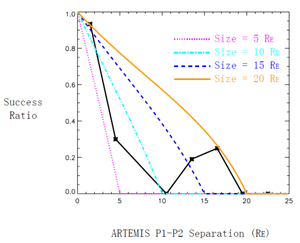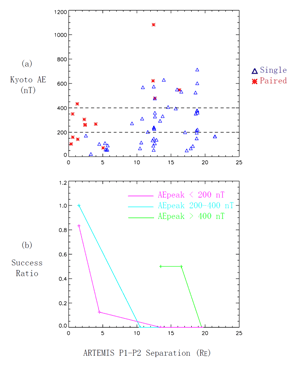2014 ARTEMIS SCIENCE NUGGETS
Azimuthal Extent and Properties of Mid-tail Plasmoids From Two-point ARTEMIS Observations at the Earth-Moon Lagrange Points
by Shanshan Li, UCLA EPSS & IGPP
Introduction
Plasmoids are remote substorm signatures in the magnetotail. Based on the near-Earth-neutral-line (NENL) substorm model, NENL reconnections on closed magnetotail field lines produce plasmoids -- hot plasma sheet bulges encompassed by curved field lines. As the reconnections proceed to open lobe field lines, plasmoids are ejected tailward.
Distant-tail observations suggest that plasmoids are extended flux ropes that lie across the entire magnetotail. Near-Earth observations, however, reveal that reconnections take place preferentially on the dusk-sector of the magnetotail and they produce structures (dipolarization fronts, bursty bulk flows, etc.) with limited azimuthal sizes (1~3 RE). As the product of NENL reconnection, plasmoids are also expected to be small-scale structures (in azimuthal direction), which disagree with the distant-tail observations.
For the first time, ARTEMIS is able to provide direct two-point observations at X~ -60 RE, where plasmoids have newly originated. We estimate the typical plasmoid extent at the mid-tail region by the correlation between the two-point observations.
Observations
Figure 1 shows the success ratios at different spacecraft separations. The success ratio is defined by how often the test spacecraft observe a plasmoid/TCR when the reference spacecraft observe a plasmoid. The observations (black) fit to the situation when a plasmoid is about 5~10 RE, except for the two points from 12 to 18 RE. We examined these atypical events and found they all happened during large substorms (AE > 400 nT).
| Figure 1. The observed success ratio (black) represents how often the test spacecraft observe the plasmoid/TCR when the reference spacecraft observe a plasmoid. The expected success ratio is plotted in magenta/cyan/blue/orange, when the plasmoid size is set as 5 RE/10 RE/15 RE/20 RE. |
Figure 2 shows the AE-index values of all the events. Clearly, all of the plasmoid events observed by both spacecraft at large separations occurred during large substorms. Hence we suggest that the typical plasmoid size is about 5 to 10 RE, whereas large substorms usually correlate with extended plasmoids.
| Figure 2. 2a shows the AE index values and ARTEMIS P1-P2 separations for each plasmoid observed by the reference spacecraft. The correlated/uncorrelated observations are marked in red star/blue triangle. 2b shows the success ratio curves for the three groups with low, moderate and large AE-index values. |
Conclusion
Two-point ARTEMIS observations reveal that the typical plasmoid azimuthal size in our dataset is indeed only about 5 to 10 RE, but it could be over 20 RE when the AE index is very large. We conclude that plasmoids during small to moderate substorms (AEpeak < 400nT) do not grow beyond ~10 RE until they have moved tailward of ~ -45 to -65 RE. Plasmoids during large substorms (AEpeak > 400nT), however, either grow beyond ~10 RE before they reach lunar distance or initially extend across a large portion of the magnetotail.
Reference
S.-S. Li, V. Angelopoulos, A. Runov, S.A. Kiehas1, X.-Z. Zhou (2013), Plasmoid growth and expulsion revealed by two-point ARTEMIS observations, J. Geophys. Res., in press.Biographical Note
Shanshan Li is a graduate student in the Experimental Space Physics Group at UCLA, under Professor Vassilis Angelopoulos. Her research interests focus on phenomena in the Earth’s magnetosphere, especially in the magnetotail. She analyzes data collected by the THEMIS/ARTEMIS spacecraft and performs both case study and statistical analyses. By studying the the dipolarization fronts (DFs) and the plasmoids with multi-point observations, her work aims to test and refine the substorm model in three-dimensional space.
 Please send comments/suggestions to
Emmanuel Masongsong / emasongsong@igpp.ucla.edu
Please send comments/suggestions to
Emmanuel Masongsong / emasongsong@igpp.ucla.edu

